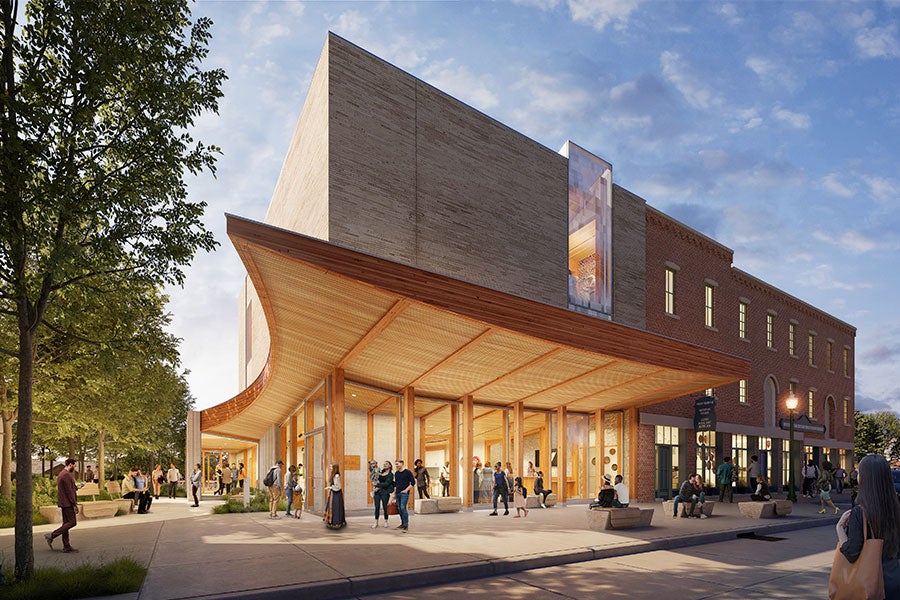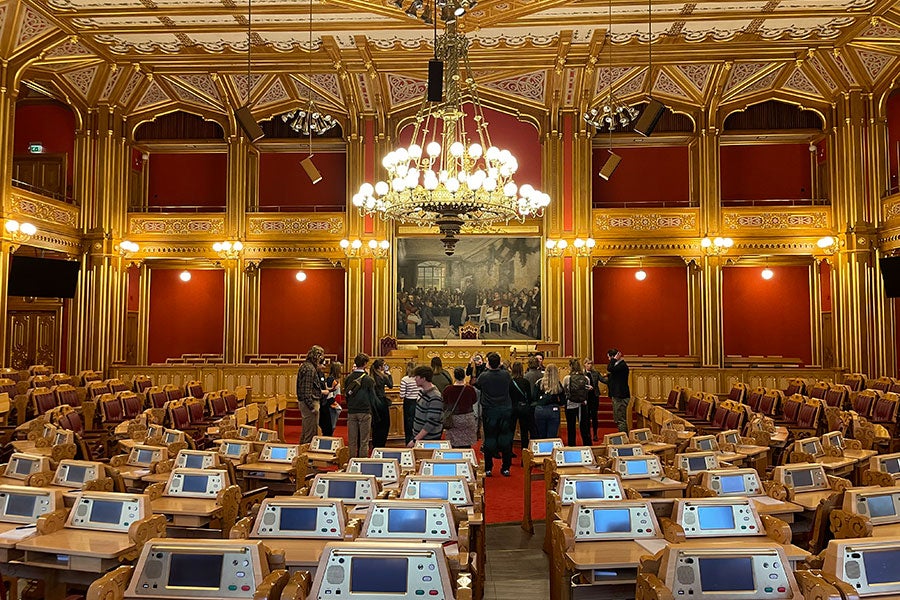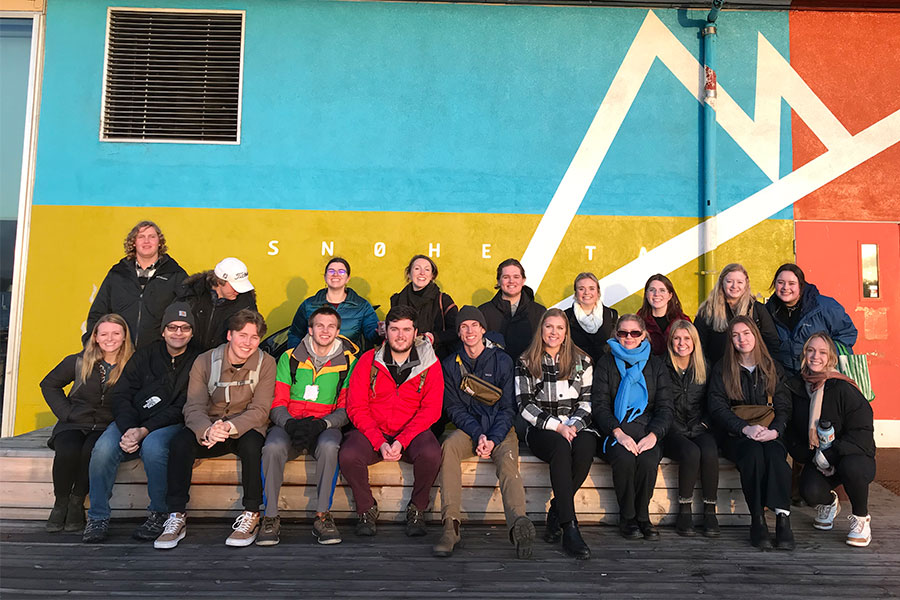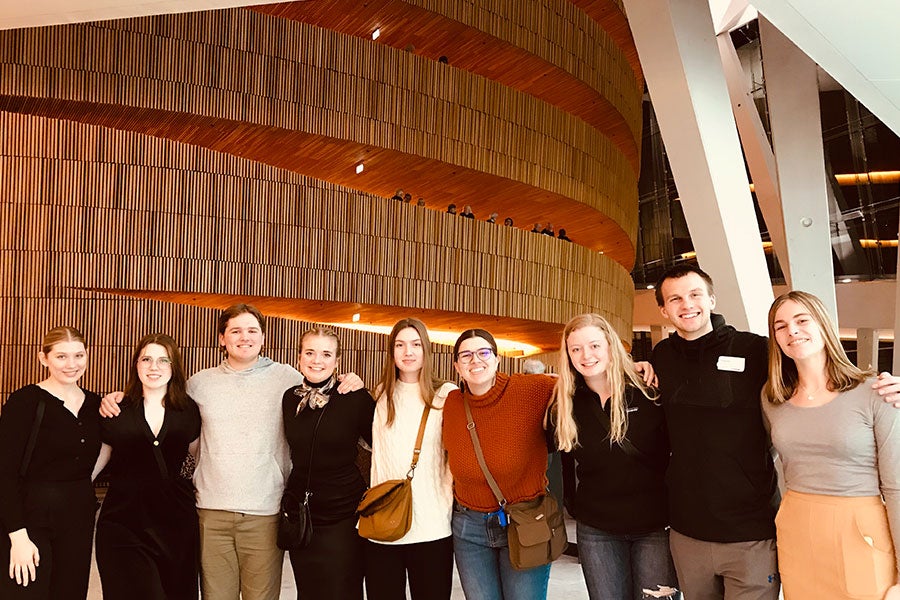Building Ethical Futures
This spring, US News and World Report ranked Luther number two in the nation for the percentage of students who study abroad. Our students choose to learn off-campus in such great numbers in part because they adopt the Luther ethos of global citizenship. They also learn off-campus because we offer some incredible study-away courses.
Case-in-point: Building Ethical Futures through Architecture, Design, and Narrative in Norway, a brand-new Paideia 450 course that professors Andy Hageman (English) and Maren Johnson (Nordic studies) offered over J-Term 2023.
The thoughtful, high-impact course asked students to think about how the design of buildings and systems reflects the values and ethics of a place.
Funny enough, this farflung course began hyper-locally, with a world-renowned architecture firm putting down roots in Decorah.

Snøhetta, a world-renowned architecture firm, is enhancing the Vesterheim Museum in Decorah (mockup at left). The project inspired a Paideia 111 unit, which inspired a brand-new study-away course in Norway. Photo courtesy of Snøhetta.
A global presence in Decorah
Snøhetta is responsible for dozens of heavy-hitting projects around the world: opera houses in Shanghai, Oslo, and Busan; libraries in Beijing, Calgary, and Alexandria; the National September 11 Memorial Museum Pavilion and Times Square in New York; and soon the Vesterheim Commons in Decorah, Iowa.
Hageman says, “We’re seeing a globally significant architecture/design firm that started from humble roots, doing things in their own, very innovative way. And they’re going to help change the landscape of Decorah and downtown.”
Plans for the visionary 7,600-square-foot Vesterheim Commons project began in 2018. Johnson, the Luther representative to Vesterheim’s Board of Trustees, remembers being struck by Snøhetta’s inclusive, collaborative, ethics-based approach to design—and the fact that it started with values. “Built spaces can help us shape the way we tell a story and invite more voices into the conversation,” she says. “In this redesign, we started with the value of the immigrant story. Narrative is a value for the museum, and it’s important for Vesterheim to put the immigrant story and the immigrant experience at the forefront.”
The Vesterheim project inspired Hageman to include a unit about it in the first-year Paideia 111 course in the fall of 2020 and 2021. “It’s really where we welcome students to the liberal arts, which I think of more as a welcome to interdisciplinary studies,” he says. “It got students to think about architecture and design as embodied values, as this intersection of fields. With Snøhetta, we thought about how you’ve got people who do physics and engineering and people who have to understand economics and accounting as they look at their budgets, and then aesthetics, art, design. What narrative does a building tell? And issues of diversity, equity and inclusion—how do we design better with those principles in mind?”
He also lifted Snøhetta up as a model of cooperation and teamwork. “Paideia means learning in community. And part of that is starting out at Luther and realizing that what you’re doing here is not just producing individual papers and analyses,” he says.

Luther students visited Norwegian parliament, where two parliamentarians talked with them about shared values and how the building design facilitates debate and discussion. Photo courtesy of Leah Crown ’23.
Learning in parliament
The Paideia 450 course in Norway took three years of planning. When it was offered last J-Term, students jumped at the chance to take their Luther learning full circle—23 out of 24 of them had taken the Snøhetta unit in Paideia 111. “They thought this would be a really interesting way to do their ethics capstone with something that was meaningful to them,” Hageman says.
While the course used Snøhetta as a jumping-off point, Johnson says, “The focus became Scandinavia and design—not just physical spaces, but societal and community design and how alternate models of life and society offer different opportunities and challenges.”
The group’s tour of Norwegian parliament is a powerful example of how design can reflect—and maybe even encourage—societal values. The Norwegian parliament building is surrounded by a waist-high gate, which visitors can open themselves before walking directly to the front door. The Luther group was met by two parliamentarians who represented opposite ends of the spectrum of Norway’s nine political parties. Hageman recalls them saying, “‘We’re going to talk for about half an hour about all the shared values that we have and what we want to accomplish together. Then we’ll take a little time to talk to you about how we disagree on how to get there.’ Then they walked us through things like: how do we together, as opposites, share a sense of health care as a human right, education as a human right, child care as a human right?”
Because Norway has so many political parties, everything has to be done as a parliament, as coalitions, and so its approach to government is a collaborative one.
The parliamentarians took the group down to the main chamber and talked about its design and how it facilitates debate and discussion. They pointed out that if you look out the window where they all sit, you can see up to the palace. They described how that monument to the history of monarchy plays into their ideas of power dynamics, parliament, and democracy.
“There was this openness and this idea that these are sacred spaces where the laws of the country are made, but it’s very possible for everyone to access them,” Johnson says. “There’s this perception there that public institutions like the government are for people.”
Hageman says, “Design and architecture—students understand that, but the narrative part was a little tricky. But that day—that day I think it clicked.”

Students on the course visited the Oslo office of Snøhetta. Almost all of them had learned about the firm as first-years. Now, they were able to take their learning to the source during their Paideia 450 ethics capstone. Photo courtesy of Andy Hageman.
Taking things full circle
The course took students through a diverse, high-impact itinerary. They toured the Edvard Munch museum, where groups of students started at different points in the space and moved through it in different ways, so they all got different narratives of it. They also toured the Nordic Black Theatre, a small independent theatre that stages shows largely written, directed, and acted by people of color. The recent immigrant stories they staged tied back to Versterheim’s focus on immigrant stories in Decorah.
The group visited Hans Brattskar ’79, special envoy of the Norwegian Foreign Ministry, who is leading a multinational, multibillion-dollar project to combat deforestation of rainforest. They took a few classes at the Oslo School of Architecture and Design. They visited a high school for top athletes in western Oslo. And, of course, they visited the Oslo office of Snøhetta, the architecture and design firm that inspired the entire course.
“Snøhetta was one of my favorite units in Paideia 111,” says Jared Penshorn ’23. “I remember admiring their unique architecture styles and the scale of their buildings. More importantly, I remember being fascinated by their visions. They were attempting to overhaul traditional architecture by being environmentally conscious with materials and reusing as many buildings as possible. They wanted to redesign old places more than design new spaces. As a young environmental science major, these ideas were inspiring to me.”
About his visit to Snøhetta’s Oslo office, Penshorn says, “I was finally able to see all these concepts and visions with my own eyes. Their buildings are grand and impressive, but I kept marveling at ways they incorporated passive solar heat and local sourcing into their designs. I found Snøhetta to be exactly as I had learned: a firm that’s looking toward the future and reimagining what’s possible in the spaces around them.”

A group of students attended an opera at the Snøhetta-designed National Opera and Ballet, which they studied as first-years in their Paideia 111 course. Photo courtesy of Andy Hageman.
Time to reimagine
Principles of design, architecture, and narrative—or DAN, as the group affectionately called it—were the cornerstone of the course. But, as with any Luther study-away course, the lessons students learned extended well beyond academics.
Johnson remembers a trying first day of travel during which the whole group lost its luggage. On the high-speed train from the airport to central Oslo, the announcement came on: The doors are closing. Please sit down. We’re headed to central Oslo. Our trip will take about 20 minutes. Two of the students started crying. When Johnson checked in with them, they explained, “It has absolutely nothing to do with logistics—it has everything to do with the fact that we realize it matters for us to learn language because we understand. We understand.” They’d studied Norwegian at Luther, and now they saw the value of having learned a language, of understanding how to navigate in a foreign city. It was profound.
Anthropology major Sam Liska ’23 left the course with a brand-new outlook. “As a class, we reflected a lot about what it means to be a student and, more importantly, a young adult in this day and age,”
he says.
Liska recalls Johnson saying that the trip was meant to show them that the world isn’t a scary place—an idea he took to heart. “Our world doesn’t have to be the overwhelmingly depressing, hopeless, and fearful place it’s often made out to be,” he says. “Rather, it’s time for us to reimagine and create the world we want to see.” He developed a new mantra to remind himself of this: to pivot is to trust. He says, “It’s a phrase to remind us that change is possible so long as there is trust in ourselves and each other.”